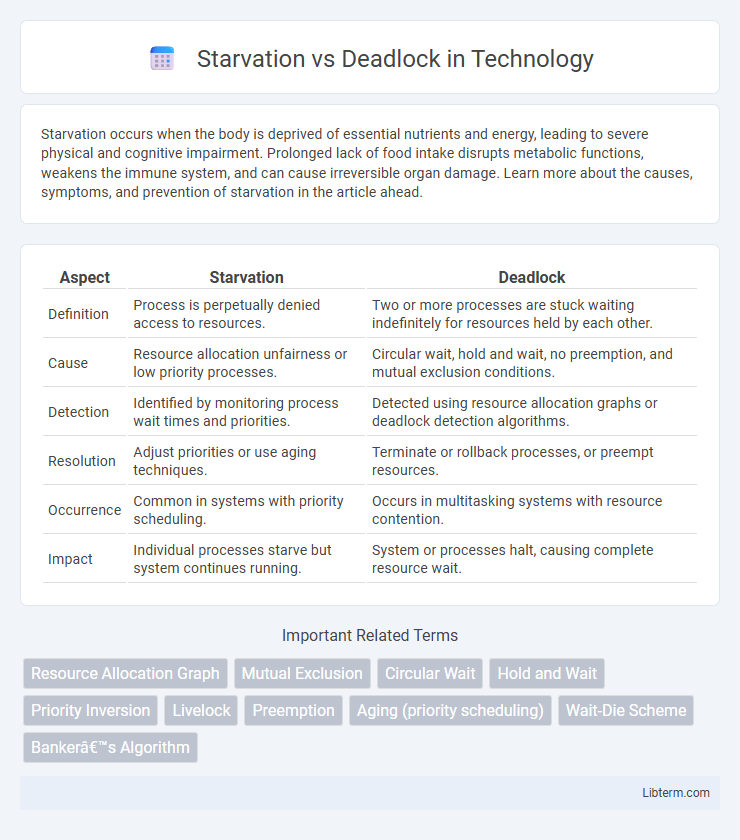Starvation occurs when the body is deprived of essential nutrients and energy, leading to severe physical and cognitive impairment. Prolonged lack of food intake disrupts metabolic functions, weakens the immune system, and can cause irreversible organ damage. Learn more about the causes, symptoms, and prevention of starvation in the article ahead.
Table of Comparison
| Aspect | Starvation | Deadlock |
|---|---|---|
| Definition | Process is perpetually denied access to resources. | Two or more processes are stuck waiting indefinitely for resources held by each other. |
| Cause | Resource allocation unfairness or low priority processes. | Circular wait, hold and wait, no preemption, and mutual exclusion conditions. |
| Detection | Identified by monitoring process wait times and priorities. | Detected using resource allocation graphs or deadlock detection algorithms. |
| Resolution | Adjust priorities or use aging techniques. | Terminate or rollback processes, or preempt resources. |
| Occurrence | Common in systems with priority scheduling. | Occurs in multitasking systems with resource contention. |
| Impact | Individual processes starve but system continues running. | System or processes halt, causing complete resource wait. |
Introduction to Starvation and Deadlock
Starvation occurs when a process is perpetually denied access to resources due to priority scheduling or resource allocation policies, causing it to wait indefinitely. Deadlock arises when a set of processes are blocked because each process holds a resource and waits for another resource held by another process, creating a cycle of dependencies with no resolution. Both conditions lead to system inefficiencies but differ in mechanisms: starvation is caused by unfair scheduling, whereas deadlock results from circular wait conditions among processes.
Defining Starvation: Causes and Effects
Starvation occurs when a process is perpetually denied access to necessary resources due to priority scheduling or resource allocation policies favoring other processes. This condition primarily arises from improper resource management, such as low-priority processes being blocked by higher-priority ones indefinitely. The effects of starvation include decreased system throughput, unfair resource distribution, and potential process failure or indefinite delay in execution.
Understanding Deadlock: Core Concepts
Deadlock occurs when a set of processes are blocked because each process is waiting for a resource held by another, creating a cycle of dependencies with no process able to proceed. Core concepts include mutual exclusion, hold and wait, no preemption, and circular wait, which are necessary conditions for deadlock to arise in operating systems. Understanding these conditions helps in designing deadlock prevention, avoidance, and detection algorithms to maintain system stability.
Key Differences Between Starvation and Deadlock
Starvation occurs when a process is perpetually denied access to necessary resources due to priority scheduling, while deadlock is a state where two or more processes are blocked indefinitely, each waiting for resources held by the others. In starvation, resource allocation is possible if priorities change, but deadlock requires intervention through deadlock detection or recovery algorithms. Starvation typically affects lower-priority processes, whereas deadlock impacts all involved processes equally, leading to a complete halt in system progress.
Common Scenarios Leading to Starvation
Starvation occurs when a process is perpetually denied access to resources because higher-priority processes monopolize them, commonly seen in priority scheduling systems where low-priority tasks wait indefinitely. Deadlock arises when a set of processes are each waiting for resources held by the others, creating a cycle of dependencies that halts progress. Common scenarios leading to starvation include priority inversion in real-time systems, continuous arrival of higher-priority tasks in CPU scheduling, and improper resource allocation in multithreading environments.
Typical Causes of Deadlock in Systems
Deadlock in systems typically arises from four primary conditions: mutual exclusion, hold and wait, no preemption, and circular wait, which collectively prevent processes from progressing. Resources are monopolized when processes hold some resources while waiting indefinitely for others, causing starvation for certain processes that never gain access. In contrast, starvation generally results from priority-based scheduling where low-priority processes are perpetually ignored, whereas deadlock leads to a complete standstill of involved processes.
Detection and Prevention Methods for Starvation
Starvation occurs when certain processes are perpetually denied necessary resources, often due to priority-based scheduling, while deadlock involves a circular wait with no process able to proceed. Detection methods for starvation focus on monitoring resource allocation and identifying processes that have waited beyond a threshold time without progress. Prevention techniques include implementing fair scheduling algorithms such as aging, where process priorities are gradually increased over time to ensure eventual resource access and avoid indefinite postponement.
Deadlock Avoidance Techniques Explained
Deadlock avoidance techniques ensure systems allocate resources dynamically to prevent circular wait conditions, using algorithms like Banker's Algorithm to evaluate resource requests and maintain safe states. These methods require pre-knowledge of maximum resource needs and carefully monitor current allocations to deny requests that could lead to deadlocks. Implementing avoidance strategies reduces system downtime and improves resource utilization in multiprogramming environments by preemptively eliminating unsafe resource allocation sequences.
Real-World Examples: Starvation vs Deadlock
Starvation occurs when a process is perpetually denied access to resources due to unfair scheduling, as seen in CPU scheduling where low-priority tasks never execute. Deadlock arises when processes hold resources while waiting indefinitely for others, exemplified by the classic dining philosophers problem or resource allocation in database systems. Practical examples include starvation in thread scheduling in operating systems and deadlock in multiprocessor environments causing complete system halt.
Best Practices for Managing Resource Allocation
Effective resource allocation strategies to prevent starvation and deadlock include implementing fair scheduling algorithms like Round Robin or Lottery Scheduling, ensuring all processes receive equitable CPU time. Employing resource ordering and the Banker's Algorithm helps avoid circular wait conditions that cause deadlocks, maintaining system stability. Regularly monitoring resource usage and applying priority aging techniques prevent indefinite blocking and promote responsiveness in multitasking environments.
Starvation Infographic

 libterm.com
libterm.com